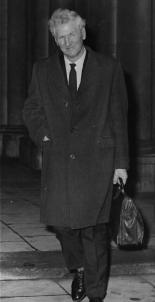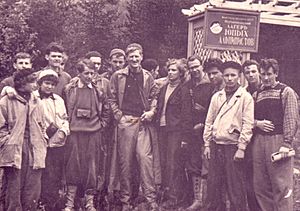John Hunt, Baron Hunt facts for kids
Quick facts for kids
The Lord Hunt
KG, CBE, DSO
|
|
|---|---|
 |
|
| Born | 22 June 1910 Simla, British India |
| Died | 7 November 1998 (aged 88) Henley-on-Thames, Oxfordshire, England |
| Allegiance | United Kingdom |
| Service/ |
British Army |
| Years of service | 1930–1956 |
| Rank | Brigadier |
| Service number | 44889 |
| Unit | King's Royal Rifle Corps |
| Commands held | 168th Infantry Brigade 11th Indian Infantry Brigade 11th Battalion, King's Royal Rifle Corps |
| Battles/wars | Second World War |
| Awards | Knight of the Order of the Garter Knight Bachelor Commander of the Order of the British Empire Distinguished Service Order |
| Other work | Mountaineer |
Sir John Hunt (born June 22, 1910 – died November 7, 1998) was a brave British Army officer. He is most famous for leading the successful expedition to Mount Everest in 1953. This was the first time anyone officially reached the top of the world's highest mountain!
Contents
Growing Up and Joining the Army
John Hunt was born in Simla, British India, on June 22, 1910. His father was an officer in the Indian Army. Sadly, his father passed away during the First World War.
From the age of 10, John spent many holidays in the Alps. Here, he learned important mountaineering skills. He continued to improve these skills during his time in India. He even climbed Piz Palu when he was just 14 years old!
John went to Marlborough College and then to the Royal Military College, Sandhurst. He was a very good student there.
Starting His Military Career
In 1930, John joined the King's Royal Rifle Corps (KRRC) as a second lieutenant. In 1931, his regiment moved to India. He became a lieutenant in 1933.
John learned to speak Urdu and some Bengali. He also preferred playing rugby over polo. In 1934, he became a Military Intelligence officer. He even worked undercover in Chittagong, dressed in local clothes, to gather information. He received the Indian Police Medal for his work.
Climbing in the Himalayas
During his time in India, John kept climbing in the Himalayas. In 1935, he tried to climb Saltoro Kangri, reaching a height of about 7,468 meters (24,500 feet). Because of this amazing climb, he became a member of the Alpine Club and the Royal Geographical Society.
He wanted to join the 1936 Everest Expedition. However, he was not allowed because a medical check found a minor heart problem.
In 1936, John married Joy Mowbray-Green. She joined him on a Himalayan trip in 1937. They explored areas around Kangchenjunga. During this trip, one of their Sherpas pointed out tracks they saw, saying they belonged to the Yeti!
John Hunt in World War II
When John returned to the United Kingdom in 1940, he became a chief instructor. He taught soldiers at the Commando Mountain and Snow Warfare School.
In 1943, he became a major and led the 11th Battalion of the KRRC. He led his battalion during the Italian Campaign. In 1944, John received the Distinguished Service Order (DSO). This award was for his excellent leadership during fierce fighting near the River Sangro. He was always at the front, planning attacks and leading patrols behind enemy lines.
In October 1944, his battalion moved to Greece. Here, tensions were rising, which would lead to the Greek Civil War. John was made a temporary brigadier and commanded the 11th Indian Infantry Brigade. He worked hard to keep peace between different groups. For his efforts, he was awarded the Commander of the Order of the British Empire (CBE) in 1945.
Leading the Everest Expedition
In 1953, John Hunt received a surprising invitation. He was asked to lead the British expedition to Mount Everest. Many people expected Eric Shipton to lead it. However, the committee decided that John's military leadership and climbing skills would give them the best chance to succeed. It was very important for this expedition to be successful.
Some climbers were not happy about the change at first. Edmund Hillary was one of them. But John quickly won them over with his honest and friendly personality. John planned for two main attempts to reach the summit. Each attempt would involve two climbers.
The Climb to the Top
The team set up their Base Camp on April 12, 1953. The next few days were spent creating a safe path through the dangerous Khumbu Icefall. Once the path was open, Sherpa teams moved tons of supplies up the mountain. They slowly built more camps higher and higher up the mountain.
By May 21, two climbers, Wilfrid Noyce and Annullu, reached the important South Col. John had chosen two pairs of climbers to try for the summit. The first pair, Tom Bourdillon and Charles Evans, set out on May 26. But they had to turn back because they were too tired high on the mountain. On the same day, John himself climbed to 8,350 meters (27,395 feet) with Da Namgyal Sherpa. They left equipment for the second summit team.
On May 28, the second pair of climbers made their attempt. The summit was finally reached at 11:30 AM on May 29, 1953. The climbers were Edmund Hillary from New Zealand and Tenzing Norgay, a Sherpa from Nepal.
News and Honors
News of their amazing success reached London on the morning of Queen Elizabeth II's coronation. When the team returned to Kathmandu, they found out that Hillary had been made a Knight Commander and John a Knight Bachelor. This was for their incredible achievement. John received his knighthood when he returned to London in July 1953.
Many other honors were given to John and the expedition team. These included medals from the National Geographic Society and the Royal Geographical Society. They also received honorary degrees from several universities.
Later Life and Public Service

After Everest, John Hunt returned to the Army. He worked as an assistant commandant at Sandhurst. He retired from the military in 1956 with the honorary rank of brigadier.
He then became the first Director of the Duke of Edinburgh Award Scheme. This program helps young people develop new skills and serve their communities. He held this job for ten years.
In 1966, he was made a Life Peer for his work with young people. This meant he became Baron Hunt. He was also the first Chairman of the Parole Board. He advised on policing in Northern Ireland, which led to changes in the police force. In 1979, he was made a Knight of the Garter.
Lord Hunt passed away on November 7, 1998, at the age of 88. He had four daughters.
See also
- Sir John Hunt Community Sports College

